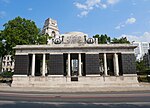John Dudley, 1st Duke of Northumberland (1504 – 22 August 1553) was an English general, admiral, and politician, who led the government of the young King Edward VI from 1550 until 1553, and unsuccessfully tried to install Lady Jane Grey on the English throne after the King's death. The son of Edmund Dudley, a minister of Henry VII executed by Henry VIII, John Dudley became the ward of Sir Edward Guildford at the age of seven. Dudley grew up in Guildford's household together with his future wife, Guildford's daughter Jane, with whom he was to have 13 children. Dudley served as Vice-Admiral and Lord Admiral from 1537 until 1547, during which time he set novel standards of navy organisation and was an innovative commander at sea. He also developed a strong interest in overseas exploration. Dudley took part in the 1544 campaigns in Scotland and France and was one of Henry VIII's intimates in the last years of the reign. He was also a leader of the religious reform party at court.
In 1547 Dudley was created Earl of Warwick and, with the Duke of Somerset, England's Lord Protector, distinguished himself in the renewed Scottish war at the Battle of Pinkie Cleugh. During the country-wide uprisings of 1549 Dudley put down Kett's Rebellion in Norfolk. Convinced of the Protector's incompetence, he and other privy councillors forced Somerset out of office in October 1549. Having averted a conservative reaction in religion and a plot to destroy him alongside Somerset, Dudley emerged in early 1550 as de facto regent for the 12-year-old Edward VI. He reconciled himself with Somerset, who nevertheless soon began to intrigue against him and his policies. Somerset was executed on largely fabricated charges, three months after Dudley had been raised to the Dukedom of Northumberland in October 1551.
As Lord President of the Council, Dudley headed a distinctly conciliar government and sought to introduce the adolescent King into business. Taking over an almost bankrupt administration, he ended the costly wars with France and Scotland and tackled finances in ways that led to some economic recovery. To prevent further uprisings he introduced countrywide policing on a local basis, appointing Lord-Lieutenants who were in close contact with the central authority. Dudley's religious policy was — in accordance with Edward's religion — decidedly Protestant, further enforcing the English Reformation and promoting radical reformers to high Church positions.
The 15-year-old King fell ill in early 1553 and excluded his half-sisters, Mary and Elizabeth, whom he regarded as illegitimate, from the succession, designating non-existent, hypothetical male heirs. As his death approached, Edward changed his will so that his Protestant cousin Jane Grey, Northumberland's daughter-in-law, could inherit the Crown.
To what extent the Duke influenced this scheme is uncertain. The traditional view is that it was Northumberland's plot to maintain his power by placing his family on the throne. Many historians see the project as genuinely Edward's, enforced by Dudley after the King's death. The Duke did not prepare well for this occasion. Having marched to East Anglia to capture Mary, he surrendered on hearing that the Privy Council had changed sides and proclaimed Mary as queen.
Convicted of high treason, Northumberland returned to Catholicism and abjured the Protestant faith before his execution. Having secured the contempt of both religious camps, popularly hated, and a natural scapegoat, he became the "wicked Duke" — in contrast to his predecessor Somerset, the "good Duke". Only since the 1970s has he also been seen as a Tudor Crown servant: self-serving, inherently loyal to the incumbent monarch, and an able statesman in difficult times.












